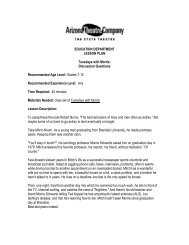Play Guide [356k PDF] - Arizona Theatre Company
Play Guide [356k PDF] - Arizona Theatre Company
Play Guide [356k PDF] - Arizona Theatre Company
- No tags were found...
Create successful ePaper yourself
Turn your PDF publications into a flip-book with our unique Google optimized e-Paper software.
The Great GatsbyTWENTIESTHE ROARING TWENTIESAt the conclusion of World War I in 1919, Americafound itself on the brink of an unparalleled era ofwealth and affluence. This transitional time provideda welcome and necessary contrast to the atrocitiesof a war that had reached a scale of global carnageunprecedented in human history. Fresh from awartime economy that boosted industry and putpaychecks in the pockets of millions of soldiers, theconcept of consumer goods erupted in the Americanmarket. People had excess cash and suddenly founda panoply of things to purchase with it, as the rapidgrowth of industry; such as automobile manufacturing,coupled with governmental policies designed tostimulate growth began to give rise to the consumerismIllustration of a flapper by Russell Pattersontitled “Where There’s Smoke There’s Fire.”that quickly became a tenet of American capitalism. Not only were the American peopleseeking an outlet for disposable income, the American psyche was also seeking arefuge and a means of relief from the horror and bloodshed of the war still fresh in theirminds. This combination of means and need provided the impetus for a decade of wildabandonment of the social and moral values of the previous age – which had led to theconflict that so scarred the globe – in exchange for newfound gaiety, freedom, artisticexploration and the smooth, unexpected sounds of jazz. The Roaring Twenties arrivedforcefully in the wake of war, and rearranged the societal norms of an entire nation.“If we ever get back [from the war] and I don’t particularly care, we’ll be ratheraged—in the worst way. After all life hasn’t much to offer except youth and Isuppose for older people the love of youth in others.” – F. Scott Fitzgerald, froma letter to his cousin CeciA still, used to produce illegalalcohol during Prohibition days.The early 1920s saw the development in America of masseverything: mass production created products efficientlyenough for the common man to afford them and massbroadcasting in the form of radio enabled the commonman to be informed of the existence of such products.Electrical recording in 1925 sparked the music industryto branch into home entertainment and advances in filmand aviation allowed communication across previouslyimmutable boundaries of time and distance. Thesenew technological forays provoked the need for animmediately adaptive infrastructure: road constructionbegan so people could use their new cars, electrificationprogressed so people could listen to their newphonographs, and local governments invested deeplyin these aspects of a new and improved world situation.<strong>Arizona</strong> <strong>Theatre</strong> <strong>Company</strong> <strong>Play</strong> <strong>Guide</strong> 17


![Play Guide [356k PDF] - Arizona Theatre Company](https://img.yumpu.com/46218320/17/500x640/play-guide-356k-pdf-arizona-theatre-company.jpg)
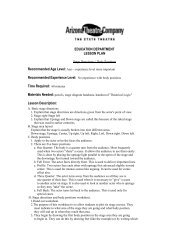



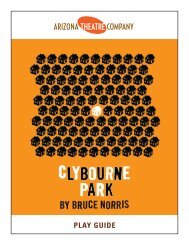
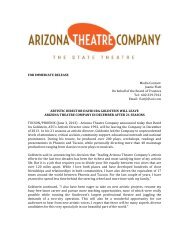
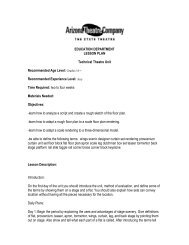

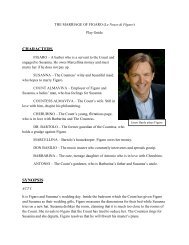
![[title of show] Arizona Theatre Company Play Guide 1](https://img.yumpu.com/24482689/1/190x245/title-of-show-arizona-theatre-company-play-guide-1.jpg?quality=85)
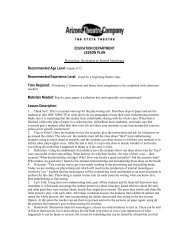
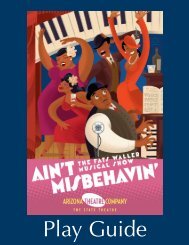
![Play Guide [1.2MB PDF] - Arizona Theatre Company](https://img.yumpu.com/11952176/1/190x245/play-guide-12mb-pdf-arizona-theatre-company.jpg?quality=85)
